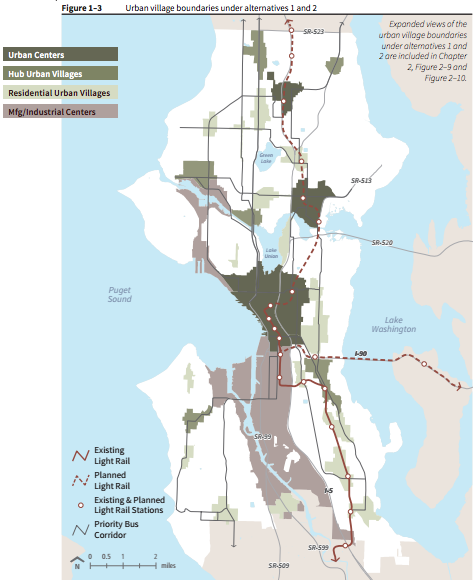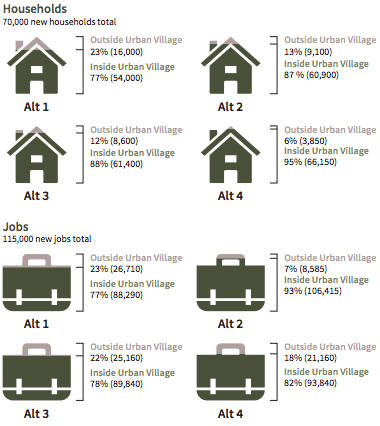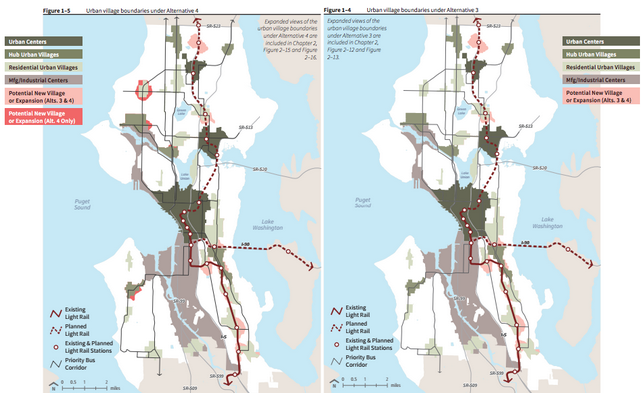
Yesterday, the City of Seattle issued the Draft Environmental Impact Statement (DEIS) for the city’s comprehensive plan update, known as Seattle 2035. The comprehensive plan update will guide how Seattle grows, and covers things like housing, land use, transportation, environment, utilities, capital facilities, parks, and neighborhoods. The 394-page DEIS is the first version of the comprehensive plan update to analyze four different alternatives for growth, their anticipated impacts, and potential options to accommodate each alternative. Specifically, Seattle 2035 spans a 20-year planning horizon and plans for 120,000 new residents and 115,000 new jobs. Each alternative considers these growth targets in their analysis.
In a statement, Seattle Mayor Ed Murray said that “Seattle’s new Comprehensive Plan will be our blueprint for a more walkable, livable community. Race and social justice must be a foundational value as we update our plan. In the coming years, we need to encourage healthy growth and prosperity for all our diverse communities.” Mirroring the heart of what the Mayor said and complementary initiatives of his administration, the DEIS sets out seven core objectives for Seattle’s future Comprehensive Plan:
- Retaining the urban village strategy and achieving a development pattern in line with it;
- Leveraging growth to create housing choices and to promote healthy, complete communities;
- Creating jobs and economic opportunity for all Seattle residents;
- Building on regional transportation investments and balancing transportation investments;
- Supporting strategic public investment that addresses areas of need and maximizes public benefit;
- Becoming a more climate-friendly city; and
- Distributing the benefits of growth more equitably.
Alternatives Evaluated by DEIS
The DEIS is built upon four alternatives: Alternative 1 which is the Continue Current Trends (No Action) Alternative, Alternative 2 which is the Guide Growth to Urban Centers Alternative, Alternative 3 which is the Guide Growth to Urban Villages Near Light Rail Alternative, and Alternative 4 which is the Guide Growth to Urban Villages Near Transit Alternative. Each alternative is demonstratively different in their land use patterns as described below:

- Alternative 1 is an approach to growth that targets land use development in the same patterns we’ve seen over the past 20 years. It focuses new job growth in Downtown Seattle and South Lake Union while residential growth takes place in urban centers and urban villages. It assumes that market trends remains generally the same as today.
- Alternative 2 guides growth to the city’s established urban centers. It assumes that these centers will become even more dominant destinations for new residents and jobs than previous decades. It has the benefit of further encouraging people to walk and bike while reducing their dependence on driving.
- Alternative 3 focuses growth in the city’s urban villages near light rail and urban centers. While growth in urban centers remains important in this alternative, special emphasis is placed on accommodating much of the growth in urban villages where they are–or will be–served by light rail transit. Boundary changes are possible within 10-minute walksheds of existing and planned light rail stations. For instance, a new urban village could be designated at I-5 and NE 130th St during the plan period while a reconfiguration of the Mount Baker and Jackson-23rd & Union urban villages could occur in conjunction with the opening of a light rail station at I-90.
- Alternative 4 envisions growth for urban villages near frequent transit, which includes both high quality bus and rail service–not just light rail. More urban villages would be slated for increased growth capacity than conceived by Alternative 3, including expanded urban villages in Ballard, Crown Hill, Fremont, and Alaska Junction.

Chapter 2.1 of the DEIS has some really big nuggets tucked away within it. Potential changes for zoning, comprehensive planning, and housing policies are recommended:
Boundaries of Urban Centers and Villages. Consider whether to expand boundaries of certain existing urban villages and create new urban villages in order to direct growth to places that have either light rail or superior bus service. Expanded boundaries of urban villages containing high-frequency transit stations would be drawn to represent a 10-minute walking distance from the transit. A possible new urban village at 130th and I-5 would recognize a future light rail station there.
Future Land Use Map. In the urban villages, potentially replace the generalized land use designations with a single designation for each type of urban village (Residential, Hub and Urban Center). The single designation would be accompanied by policies that describe the types and intensities of uses allowed in each type of village. This change is intended to provide greater clarity about the planned future development pattern in each type of urban village and indicate limits to the most intense growth.
Rezone Criteria. Potentially eliminate land use policies that establish detailed and strict criteria about when it is appropriate to change zoning from a single-family designation. This is the only zoning category that is addressed this way in the Plan and is at a level of detail that is more appropriate for the Land Use Code.
Homeownership. Consider eliminating the goal of increasing home ownership over time as outdated and no longer applicable in Seattle.
Affordable Housing. Consider adding affordable housing as an appropriate use of City surplus land, along with some guidance for how to select among the various possible uses of surplus property. Potentially incorporate new policies that emerge from the City’s Housing Affordability and Livability Agenda.
Each of these may seem like brief and simple statements on potential changes, but they represent a huge shift. For instance, the proposal to simplify the Future Land Use Map (FLUM) designations in urban village designated areas could provide greater flexibility, certainty, and clarity. Currently, urban villages consist of designated boundaries on the FLUM, but underlying land use designations are still called out separately and generalized, which add a significant degree of ambiguity on how zoning should be implemented within the urban villages. It’s conceivable that the urban village districts can be better described at the subarea plan level or in policies as opposed to ambiguously indicated on the FLUM. Meanwhile, dropping the goal of homeownership is a strong statement that the city should be focused on all tenancy types regardless of whether a resident is a renter, social welfare or co-op tenant, or condo or fee simple property owner.
How To Get Involved
The Department of Planning and Development (DPD) is seeking public input on Seattle 2035. A 45-day public comment has been opened and will run until June 18, 2015. While all comments will be considered in Final Environmental Impact Statement, it is best to provide DPD with comprehensive comments covering issues you think are important for the Department to analyze and why one alternative–or combination of alternatives–is best. You can visit the online open house to explore the elements of the DEIS and take a quick online survey.
DPD will hold a public open house and hearing on May 27th from 6pm to 8pm at City Hall in the Bertha Knight Landes Room. Additionally, written comments can be sumbitted online, at 2035@seattle.gov, or mailed to DPD.
Stephen is a professional urban planner in Puget Sound with a passion for sustainable, livable, and diverse cities. He is especially interested in how policies, regulations, and programs can promote positive outcomes for communities. With stints in great cities like Bellingham and Cork, Stephen currently lives in Seattle. He primarily covers land use and transportation issues and has been with The Urbanist since 2014.


